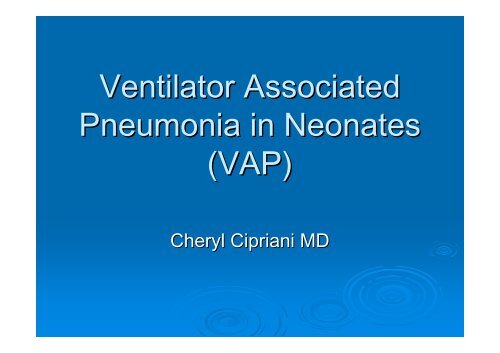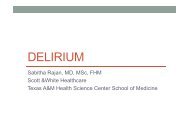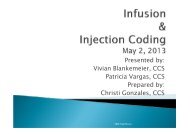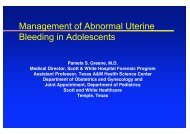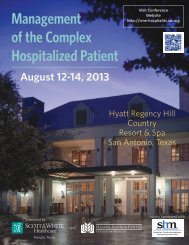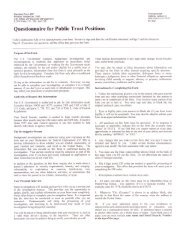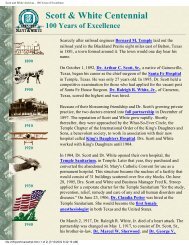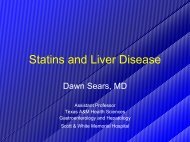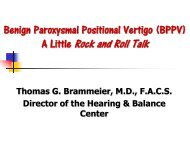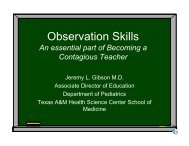(VAP) in Neonates - Healthcare Professionals
(VAP) in Neonates - Healthcare Professionals
(VAP) in Neonates - Healthcare Professionals
You also want an ePaper? Increase the reach of your titles
YUMPU automatically turns print PDFs into web optimized ePapers that Google loves.
Ventilator Associated<br />
Pneumonia <strong>in</strong> <strong>Neonates</strong><br />
(<strong>VAP</strong>)<br />
Cheryl Cipriani MD
Institute for <strong>Healthcare</strong><br />
Improvement Initiative<br />
‣ Save 100,000 lives by<br />
June 2006 by<br />
implement<strong>in</strong>g<br />
evidence-based<br />
<strong>in</strong>terventions <strong>in</strong> 6<br />
areas: 1. Prevention<br />
of Ventilator<br />
Associated<br />
Pneumonia
CDC Def<strong>in</strong>ition of <strong>VAP</strong><br />
‣ An episode of pneumonia <strong>in</strong> a patient who<br />
requires a device to assist or control<br />
respiration through a tracheostomy or<br />
endotracheal tube with<strong>in</strong> 48 hours before<br />
the onset of <strong>in</strong>fection.
Diagnosis of <strong>VAP</strong>
CDC Criteria for Diagnosis of <strong>VAP</strong><br />
<strong>in</strong> Infants < 1 Year of Age<br />
‣ On mechanical ventilation for 48 hours or<br />
more<br />
AND<br />
‣ Worsen<strong>in</strong>g gas exchange (O2<br />
desaturations, , Increased requirement for<br />
supplemental O2, or <strong>in</strong>creased need for<br />
ventilation)<br />
AND
CDC Criteria for Diagnosis of <strong>VAP</strong><br />
<strong>in</strong> Infants < 1 Year of Age<br />
At least 3 of the follow<strong>in</strong>g:<br />
1. Temperature <strong>in</strong>stability<br />
2. Leukopenia(<br />
15,000 WBC) & left<br />
shift (>10%bands)(<br />
3. New onset purulent<br />
sputum, change <strong>in</strong><br />
character sputum,<br />
↑secretions, suction<strong>in</strong>g
CDC Criteria for Diagnosis of <strong>VAP</strong><br />
<strong>in</strong> Infants < 1 Year of Age<br />
4. Apnea, tachypnea, , nasal flar<strong>in</strong>g with<br />
retraction of chest wall, or grunt<strong>in</strong>g<br />
5. Wheezes, crackles, or rhonchi<br />
6. Cough<br />
7. Bradycardia (170 beats/m<strong>in</strong>)<br />
AND Two or more serial chest x-raysx<br />
with<br />
one of the follow<strong>in</strong>g:
CDC Criteria for Diagnosis of <strong>VAP</strong><br />
<strong>in</strong> Infants < 1 Year of Age<br />
‣ New or progressive<br />
<strong>in</strong>filtrate<br />
‣ Consolidation<br />
‣ Cavitations or<br />
pneumoceles
<strong>VAP</strong><br />
Second most<br />
common nosocomial<br />
<strong>in</strong>fection <strong>in</strong> hospital<br />
ICU’s
What % Nosocomial Infections are<br />
<strong>VAP</strong><br />
‣ NICU’s: : 6.8-32.3%<br />
‣ PICU: 22.7%<br />
‣ Adult ICU’s: 15-30%
National <strong>Healthcare</strong> Safety<br />
Network: <strong>VAP</strong> by Birthweight<br />
< 750 g 2.6 cases/1000 ventilator days<br />
751-1000 1000 g 2.1 cases/1000 ventilator days<br />
1001-1500 1500 g 1.5 cases/1000 ventilator days<br />
1501-2500 g 1 case/1000 ventilator days<br />
>2500 g 0.9 cases/1000 ventilator days
Neonatal Immune System & <strong>VAP</strong><br />
‣ <br />
permeability of sk<strong>in</strong> &<br />
mucous membranes<br />
‣ ↓complement activity<br />
‣ Abnormal granulocyte<br />
chemotaxis & kill<strong>in</strong>g<br />
ability<br />
‣ Lower immuno-<br />
globul<strong>in</strong> levels
Risk Factors for <strong>VAP</strong> <strong>in</strong> <strong>Neonates</strong><br />
‣ Poor hand hygiene<br />
‣ Prolonged <strong>in</strong>tubation<br />
‣ Re-<strong>in</strong>tubation<br />
‣ Opiates for sedation<br />
‣ Frequent suction<strong>in</strong>g<br />
‣ Prior bloodstream<br />
<strong>in</strong>fection<br />
‣ Crowd<strong>in</strong>g &<br />
understaff<strong>in</strong>g
Crowd<strong>in</strong>g & Understaff<strong>in</strong>g<br />
‣ In a prospective study<br />
<strong>in</strong> 2002 of nosocomial<br />
<strong>in</strong>fection, there was a<br />
significant drop <strong>in</strong><br />
<strong>VAP</strong> when a move<br />
was made to a larger<br />
NICU with 50% more<br />
staff<strong>in</strong>g
Lateral Position<strong>in</strong>g: Pediatrics<br />
2008;122:770-4<br />
Lateral Group<br />
N=30<br />
Sup<strong>in</strong>e Group<br />
N+30<br />
% Positive<br />
Tracheal<br />
Cultures 2 days<br />
47%<br />
67% (P=0.12)<br />
% Positive<br />
Tracheal<br />
Cultures 5 days<br />
30%<br />
87% (P=
Pediatrics 2008:121:e253-9<br />
‣ Peps<strong>in</strong>, a marker for<br />
gastric contents found<br />
<strong>in</strong> the trachea of 92%<br />
of a group of<br />
ventilated <strong>in</strong>fants
‣ <strong>Neonates</strong> may be at<br />
greater risk for<br />
aspiration because<br />
their ET tubes are<br />
uncuffed<br />
Aspiration & <strong>VAP</strong>
PSB<br />
culture<br />
<strong>VAP</strong> Diagnosis Crit. Care Med<br />
Technique<br />
ET aspirate<br />
culture<br />
BAL culture<br />
1999;27:2537-43<br />
Sensitivity(%)<br />
N=103<br />
93<br />
69<br />
72<br />
Specificity(%)<br />
N=103<br />
41<br />
95<br />
88<br />
PSB & BAL<br />
cultures, ICB<br />
90<br />
88
Organisms that Cause <strong>VAP</strong><br />
‣ Staphylococcus aureus<br />
‣ Pseudomonas aerog<strong>in</strong>osa<br />
‣ Escherichia coli<br />
‣ Klebsiella pneumonia<br />
‣ Enterobacter Species<br />
‣ Ac<strong>in</strong>etobacter species
Utility of Gram Sta<strong>in</strong><strong>in</strong>g: J Per<strong>in</strong>atol<br />
2010;30:270-4<br />
Gram positive<br />
cocci(%)<br />
Gram negative<br />
rods (%)<br />
Sensitivity<br />
82<br />
100<br />
Specificity<br />
100<br />
82
Infection Control Measures<br />
‣ Staff education<br />
‣ Alcohol-based hand-<br />
dis<strong>in</strong>fection<br />
‣ Isolation to reduce<br />
cross-contam<strong>in</strong>ation<br />
contam<strong>in</strong>ation<br />
with multi-drug<br />
resistant organisms<br />
‣ Surveillance of ICU<br />
<strong>in</strong>fections
Hand Hygiene <strong>in</strong> an NICU<br />
‣ After <strong>in</strong>tervention, appropriate hand<br />
cleans<strong>in</strong>g ↑ from 43-80%<br />
‣ After <strong>in</strong>tervention, rate of respiratory<br />
<strong>in</strong>fections ↓ from 3.35 to 1.06 per 1000<br />
patient days (p=.002)<br />
J. Infec. . Dis. 1983;147:635-41<br />
41
<strong>VAP</strong> Prevention: Bundle of Best<br />
Practices<br />
‣ Avoid or ↓ duration of mechanical ventilation<br />
‣ Use oral ET & orogastric tubes to ↓ s<strong>in</strong>usitis<br />
‣ Avoid heavy sedation & paralytics to ↓<br />
aspiration risk<br />
‣ Prevent ventilator tub<strong>in</strong>g condensate from<br />
enter<strong>in</strong>g airway<br />
‣ Elevate HOB 30-45 degrees<br />
‣ Assess extubation read<strong>in</strong>ess daily
<strong>VAP</strong> Prevention: Bundle of Best<br />
Practices<br />
‣ Oral care and hygiene<br />
‣ Use separate devices for oral &<br />
endotracheal suction<strong>in</strong>g<br />
‣ Dur<strong>in</strong>g the 1 st 6 months these best<br />
practices were used, time between <strong>VAP</strong><br />
episodes tripled
Bundle of Best Practices<br />
‣ Cl<strong>in</strong> Per<strong>in</strong>atol 2010;37:629-43<br />
Jeffery Garland
Incidence of <strong>VAP</strong> at Scott & White<br />
Year<br />
Incidence of <strong>VAP</strong>/ 1000<br />
ventilator days<br />
2007<br />
7.81<br />
2008<br />
5.31
S&W <strong>VAP</strong> Prevention Bundle:<br />
General practices<br />
‣ Practice good hand hygiene<br />
‣ Dis<strong>in</strong>fect high-touch surfaces of equipment<br />
every 12 hr shift<br />
‣ Elevated head of bed 15-30 degrees
S&W <strong>VAP</strong> Prevention Bundle: Oral<br />
Care & Suction<strong>in</strong>g<br />
‣ Provide consistent oral care q 3-43<br />
4 hrs<br />
(Biotene<br />
& Nystat<strong>in</strong>)<br />
‣ Avoid break<strong>in</strong>g ventilator circuit, change it<br />
only when it is soiled, contam<strong>in</strong>ated<br />
‣ Use <strong>in</strong>-l<strong>in</strong>e suction catheters, change only<br />
when soiled, contam<strong>in</strong>ated, compromised<br />
‣ Use separate suction setup for oral & ETT<br />
‣ R<strong>in</strong>se oral suction devices with sterile H20<br />
or sal<strong>in</strong>e after each use
S&W <strong>VAP</strong> Prevention Bundle: Oral<br />
Care & Suction<strong>in</strong>g<br />
‣ Oral suction devices kept <strong>in</strong> plastic bag,<br />
both changed q 24 hrs<br />
‣ Suction canisters & tub<strong>in</strong>g changed q wk<br />
‣ ETT suction<strong>in</strong>g – only as cl<strong>in</strong>ically <strong>in</strong>dicated<br />
‣ Avoid <strong>in</strong>stallation of sal<strong>in</strong>e <strong>in</strong> ETT with<br />
suction<strong>in</strong>g unless plugged<br />
‣ When suction<strong>in</strong>g, wear clean gloves & open<br />
sal<strong>in</strong>e ampules with alcohol pad
S&W <strong>VAP</strong> Prevention Bundle:<br />
Intubation & Ventilator Mangement<br />
‣ Intubation – 1 attempt per ETT<br />
‣ Assess daily for extubation<br />
‣ Dra<strong>in</strong> condensate from circuit q 2-42<br />
4 hrs & prn<br />
‣ Wear gloves anytime ventilator circuit is opened<br />
‣ Keep ventilator circuit cap <strong>in</strong> clean plastic bag<br />
taped to ventilator<br />
‣ Device to hold ETT n place to ↓ extubations & re-<br />
<strong>in</strong>tubations
ZAP <strong>VAP</strong><br />
‣ <strong>VAP</strong> rate 2009:<br />
5.14/1000<br />
ventilator days
Re-evaluation evaluation of Bundle<br />
‣ Added bacterial filters to Delivery Room<br />
Ventilators and Transport Ventilator<br />
‣ Changed Conventional ventilator circuits<br />
twice/wk & high frequency circuits<br />
once/week
Most Important<br />
‣ Two PICC l<strong>in</strong>e<br />
nurse’s s were hired<br />
‣ Educated staff about<br />
nosocomial <strong>in</strong>fection<br />
prevention<br />
‣ Monitored staff<br />
‣ Changed culture of<br />
the unit
<strong>VAP</strong> Prevention at S&W<br />
‣ 2010 <strong>VAP</strong> rate:<br />
2.33/1000 ventilator<br />
days<br />
‣ 361 DAYS WITHOUT<br />
<strong>VAP</strong>!


